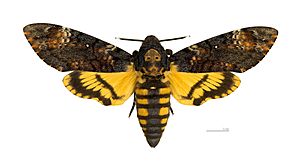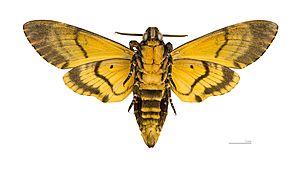African death's head hawkmoth facts for kids
Quick facts for kids Acherontia atropos |
|
|---|---|
 |
|
| Acherontia atropos ♀ | |
 |
|
| Acherontia atropos ♀ △ | |
| Scientific classification | |
| Kingdom: | |
| Phylum: | |
| Class: | |
| Order: | |
| Family: | |
| Subfamily: | |
| Genus: | |
| Binomial name | |
| Acherontia atropos (Linnaeus, 1758)
|
|
Acherontia atropos is the most well-known of the three types of Death's-head Hawkmoth. It is famous for the skull-like pattern on its body.
Contents
What Does the Death's-head Hawkmoth Look Like?
This moth has a wingspan of about 10 to 13 cm (4 to 5 inches). Its top wings are mostly dark brown or black. They have a dusty white look with many black and dark red stripes. Each top wing has a small white spot in its center.
The bottom wings are yellow or yellow-brown. They have two black lines near their edges. The moth's head and thorax (the middle part of its body) are dark brown or black. They match the color of the top wings. On the thorax, there is a dark brown spot that looks like a human skull. This special mark gives the moth its name. However, some moths might not have this spot. The abdomen (the back part of its body) is blackish-blue. It has a row of yellow spots on each side.
Where Does This Moth Live?
Acherontia atropos is found in many places. It lives from northern Africa all the way to the Middle East. You can find it as far north as southern Great Britain. It also lives on islands like the Canary Islands, Madeira, and the Azores.
When Can You See Them Flying?
These moths are usually seen flying from March to September in their normal homes. Sometimes, they might appear as early as February or as late as October. They have many broods each year. A brood is a group of offspring (baby moths) born at the same time.
How Do Death's-head Hawkmoths Behave?
Acherontia atropos can make a loud cry if a predator (an animal that hunts it) attacks. It makes this sound by pushing air out of its proboscis. The proboscis is like the moth's mouth, used for feeding. If the sound doesn't scare the predator, the moth will quickly flash its abdomen. This shows off its bright yellow spots.
These moths are most active from evening until after midnight. They are often drawn to lights. They like to feed on the sweet liquid called nectar from plants. Some of their favorite plants include Potato, Tobacco, Sweet William, and Orange blossoms.
At night, Acherontia atropos will sometimes raid beehives. They only attack the beehives of Western honey bees. Guard bees at the entrance of the hive will try to stop the moth. But Acherontia atropos is immune to the bees' venom. The moth can also mimic the bees' scent. This helps it sneak past the guards. The moth then feeds on the honey. It uses its sharp proboscis to break through the honeycombs.
Life Cycle of the Death's-head Hawkmoth
The life cycle of this moth has several stages: egg, caterpillar, and chrysalis.
Egg Stage
Female Acherontia atropos moths lay one egg at a time. They place each egg on the underside of a host plant leaf. A host plant is the plant that the caterpillar will eat. The eggs are usually green or a gray-blue color. Just before they hatch, they turn a yellowish color.
Caterpillar Stage
When a caterpillar first hatches, it is yellow-green. It has a very long, black horn at the end of its body. After it sheds its skin for the first time, it becomes greener. It develops yellow stripes on each side of its body. There are also many small white and yellow bumps on its skin.
After shedding its skin a second time, the yellow stripes get blue or purple edges. The horn becomes yellow-green with a black bottom part. After the third skin shed, the caterpillar turns more yellow. It gets a row of black spots along each side of its body. The blue or purple edges on the yellow stripes become thicker.
After its last skin shed, the caterpillar becomes even more yellow. All its colors are brighter, and it no longer has bumps on its body. The horn is now yellow and points downward. It has many small bumps on it. The caterpillar can grow to about 13 cm (5.1 inches) long.
Before it changes into a chrysalis, the caterpillar starts to get darker. It also covers itself with saliva, which makes it darken even faster. Once this is done, it looks for a good place to pupate. To pupate means to turn into a pupa.
These caterpillars do not move around much. They only move to find fresh leaves to eat. If a caterpillar is attacked, it will make sounds with its mandibles (jaws). They can also bite very hard if they feel threatened.
Chrysalis Stage
The caterpillar will pupate 15 to 40 cm (6 to 16 inches) deep in the ground. The chrysalis is a shiny brown color. It is about 7.5 to 8 cm (3 to 3.1 inches) long. If something disturbs it, the chrysalis can move. The chrysalis will hibernate (sleep through the winter). Sometimes, Acherontia atropos will hibernate as a caterpillar instead. These moths do not survive the winter in Europe.
What Plants Do They Eat?
Here is a list of plants that Acherontia atropos caterpillars like to eat:
- Atropa belladonna – also known as Deadly Nightshade
- Datura stramonium – also known as Thorn Apple
- Jasminum officinale – also known as Common Jasmine
- Lycium barbarum
- Lycium europaeum
- Nicotiana tabacum – also known as Tobacco
- Solanum dulcamara
- Solanum tuberosum – also known as Potato
Images for kids
-
Detail of the Acherontia atropos "skull" marking
See also
 In Spanish: Esfinge de la muerte africana para niños
In Spanish: Esfinge de la muerte africana para niños



